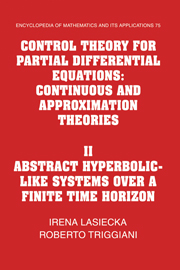Book contents
- Frontmatter
- Contents
- Preface
- 7 Some Auxiliary Results on Abstract Equations
- 8 Optimal Quadratic Cost Problem Over a Preassigned Finite Time Interval: The Case Where the Input → Solution Map Is Unbounded, but the Input → Observation Map Is Bounded
- 9 Optimal Quadratic Cost Problem over a Preassigned Finite Time Interval: The Case Where the Input → Solution Map Is Bounded. Differential and Integral Riccati Equations
- 10 Differential Riccati Equations under Slightly Smoothing Observation Operator. Applications to Hyperbolic and Petrowski-Type PDEs. Regularity Theory
- Index
9 - Optimal Quadratic Cost Problem over a Preassigned Finite Time Interval: The Case Where the Input → Solution Map Is Bounded. Differential and Integral Riccati Equations
Published online by Cambridge University Press: 05 April 2013
- Frontmatter
- Contents
- Preface
- 7 Some Auxiliary Results on Abstract Equations
- 8 Optimal Quadratic Cost Problem Over a Preassigned Finite Time Interval: The Case Where the Input → Solution Map Is Unbounded, but the Input → Observation Map Is Bounded
- 9 Optimal Quadratic Cost Problem over a Preassigned Finite Time Interval: The Case Where the Input → Solution Map Is Bounded. Differential and Integral Riccati Equations
- 10 Differential Riccati Equations under Slightly Smoothing Observation Operator. Applications to Hyperbolic and Petrowski-Type PDEs. Regularity Theory
- Index
Summary
The present chapter studies the same problem of Chapter 8 under a still different set of assumptions. Thus, the present chapter is a companion of, and a successor to, Chapter 8. The present setting specializes the framework of Chapter 8 in one important respect: The input → solution operator L0 is now continuous (in the sense of (9.1.10)). Yet the present setting is generally not properly contained in that of Chapter 8 because of a technicality, in that R need not be boundedly invertible. Moreover, it contains a more general cost functional, which penalizes also the final state through an observation operator G.
Nevertheless, the present treatment in Sections 9.3.1 through 9.3.4 follows the presentation of the variational approach of Chapter 8 very closely, with appropriate, and at times serious, technical modifications and additions, such as the evolution property of Lemma 9.3.2.2 and Lemma 9.3.4.2, due to the presence of G. Eventually, Chapter 8 and Chapter 9 merge at the level of showing uniqueness of the Riccati operator in Section 9.3.5. Finally, Section 9.3.6 provides a second proof of Theorem 9.2.2 by the direct method, which now takes advantage of the continuity in time on the basic state space of the optimal solution. This property – due to assumption (A.1) – was unavailable in Chapter 8. The abstract setting of each of the two Chapters 8 and 9 is motivated by different types of applications to partial differential equations. This is clearly illustrated by the examples of application presented at the end of Chapter 9 [as well as in Chapter 10].
- Type
- Chapter
- Information
- Control Theory for Partial Differential EquationsContinuous and Approximation Theories, pp. 765 - 918Publisher: Cambridge University PressPrint publication year: 2000



